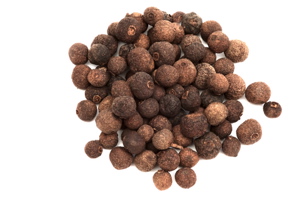I happen to be at an
event. Not one of my events but another person’s event. He was giving calm
precise direction whenever I saw him. Always smiling but still firm. After
about an hour I happened upon a chance to speak to him. I told him he was doing
a great job of organizing. I smiled at him and said he was directing things
like Spielberg.
He stopped dead in his
tracks and stared daggers at me. He grimaced, shook his head and stormed off.
Uhhhhmmm….. Ok Dude your event looks more like Nero
is in charge. Strange…..
I made a recipe the other
day of plum bread and it called for crushed allspice.
I complied and poured out the
little wooden looking balls and proceeded to crush them in a mortar. When they
were smashed to powder I added them. The bread is delicious. But what exactly
are those little wooden balls known as allspice? They have an aroma, when
ground that smells like a combination of cinnamon, clove and nutmeg.
Allspice is also known as
Jamaican Pepper, myrtle pepper, pimenta, and newspice and is the unripen dried
fruit of a tree native to Southern Mexico, Greater Antilles and Central
America. It grows very well and thrives with little help on the island of Jamaica.
When dried the fruit resembles
peppercorns and is why the Spanish explores named the fruit pimenta. Allspice is sold in the berry form because
the flavor lasts longer and the aromas are readily released when newly crushed
before use.
It is used as an
ingredient in Caribbean jerk seasoning
mole` sauces,
and in pickling, also in
many Middle Eastern dishes,
sausage making,
and barbecue sauces.
The Mayans used Allspice
in their embalming practices, and South American Indians to flavor chocolate.
Now for the part that
caught my attention, you will soon know why. Remember I said it was known as Jamaican
pepper. Let me tell you a story….
The natives, known as the
Arawak, on the island of Jamaica used allspice berries, the wood and the leaves
to preserve, smoke and cure meat. This cured meat was called boucan. As European explores came to Jamaica they
learned of the spiced, cured meats and took to curing their own meats this way
calling the process boucaniering.
The
men who cured their meat with smoke and spice were called boucaniers and later buccaneers.
These Buccaneers started trading with the Spanish who would stop for fresh
water and supplies. This blossomed into trading with any and all ships
including Pirates who sailed the Spanish Main. As a reference, the mainland of
the North and South American continents enclosing the Caribbean Sea and the
Gulf of Mexico was referred to as the Spanish Main. As business grew the
Buccaneers expanded and moved to more areas and larger towns and cities. The
Buccaneers became more powerful. This caused the Spanish to declare war on
them. The Buccaneers moved to Tortuga which was very defensible and set up a
fortress and began their new endeavor – to harass the Spanish and their ships.
The Spanish in retaliation made it their
mission to slaughter all the animals available to Tortuga and ruin their livelihood
bringing them into submission. By this time there were English and French
Buccaneers on Tortuga.
This “starvation” worked. The Buccaneers had
to find a way to survive and so they did. Instead of hunting animals they started
hunting Spanish Galleons and were labeled Pirates. Because of their skill at
hunting which insured their livelihood the Buccaneers were expert shots and
greatly feared.
One of the most famous of
the Buccaneers to come from Tortuga was Francois L'Ololonnais.
It was whispered
among his crew that he cut out the heart of a Spanish captive and gnawed on it
when the man refused to give the location of a trade route. His quickly became
known as a “blood thirsty” Pirate.
Sail safe my friends!!












No comments:
Post a Comment